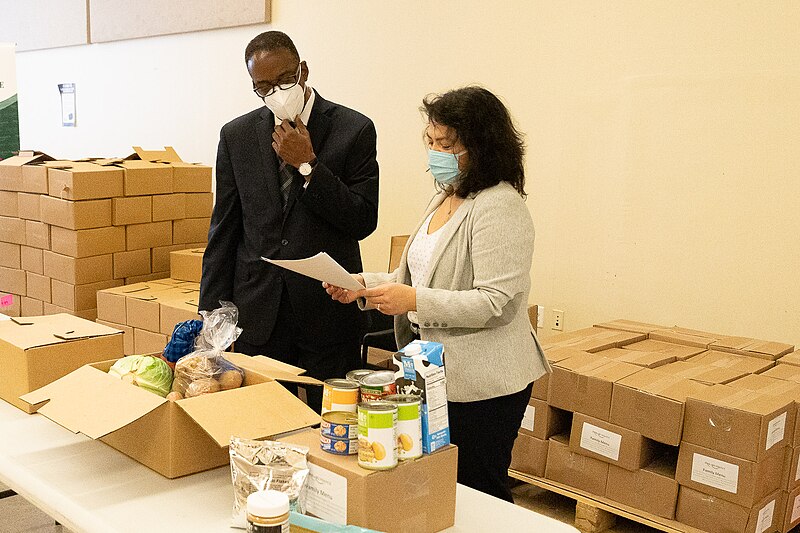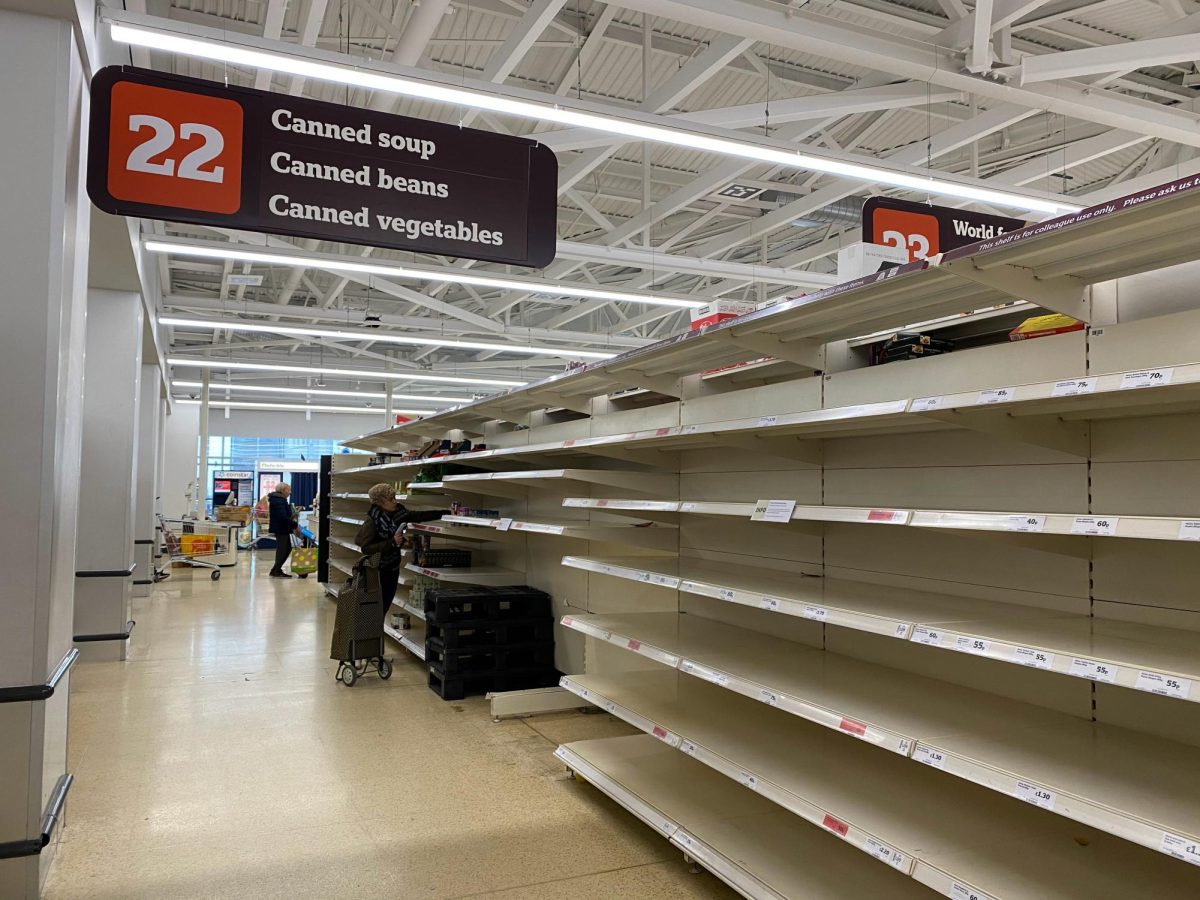Beep. Two loaves of white bread. $4.58. I’ve got to make this stretch for the next two weeks.
Beep. A single carton of eggs. $8.78. Eggs are good. The kids need their protein, but what if the price goes up again?
Beep. Two liters of Pepsi Cola. $1.69. Not the healthiest choice, but the fruit juice will make me go over budget.
Beep. A pack of rice. $5.59. Rice again. It’s getting harder to make it interesting.
The screen loads. The total? $29.50, right under 30 dollars.
This scenario is a reality for many, causing apprehension when going shopping for their next meal. Food insecurity is a daily struggle with a series of difficult decisions being made as to how much money can be dedicated to groceries and proper nourishment when other critical needs need attending to.
In 2022 alone, 12.8% of individuals in the United States struggled with purchasing enough food for their family. This is not just a statistic, but rather part of a widespread struggle that extends its impact to health, education, and economic stability. As we witness the realities of hunger within our communities and in the media, it is important to pinpoint the causes in order to determine how we can ensure that access to nutritious food is available to all.
The Causes
Economic hardship is one of the main drivers of food insecurity. For 78% percent of Americans in 2024, their lived reality consists of living from paycheck-to-paycheck, where a single financial setback can mean the difference between having food on the table or not. In neighborhoods where the median income is low, the choice between paying for housing, healthcare, or groceries is a regular occurrence. This economic strain, especially prevalent in urban areas, directly correlates with access to nutritious food.
Unstable employment has been recorded as a recurring challenge to affording three square meals a day. Many jobs are not widely available to certain individuals due to obstacles in attaining requirements such as language proficiency, higher education , literacy, and more recently, digital skills. When people are not able to check all the boxes to qualify for a stable employment opportunity with access to health insurance, pension plans, and other benefits, they can often only work short-term positions. These include jobs with fixed end dates, seasonal work, or participation in the gig economy.
The unpredictability inherent from jobs that operate on a payment-by-task basis such as deliveries, providing ride-hailing services through companies like Uber, and participating in property sharing, mirrors the uncertainty of wondering whether there will be an absolute guarantee of their next few meals while also managing other expenses. 30% of individuals in this short-term industry rely on this income as their primary source, while for 40%, it serves as a supplementary option. According to a study by Dr. Mathieu Despard, an accomplished academic and researcher at UNC Greensboro, when issuing a survey to gig workers, 33% reported that they experienced food insecurity. Additionally, employees also face the risk of layoffs, salary reductions, and job insecurity, which gives added pressure to their amounting struggles.
In spring 2022, Brenda Ann Kenneally, an American photojournalist, traveled around America to visit individuals who struggle with food insecurity. On one particular visit in Hatch, New Mexico, onion field workers were found laboriously hand-picking each onion, earning a meager $15 per box. This limited pay, along with being a farther distance from food distribution centers, forced these workers to rely on simplistic meals made from scratch. Among these hardworking individuals are the Reyes family, all of whom work on the fields, with some starting as young as twelve years old in order to make ends meet.
The problem does not end with young families, as the older population also experience significant food insecurity. For the elderly and disabled, mobility can be a significant roadblock to getting sufficient food. Accessing food distribution centers, grocery stores, or community pantries becomes arduous when physical limitations confine them to their homes. The inability to travel easily exacerbates their struggle to secure regular meals.
Navigating health conditions also often sets off a challenging feedback loop. While proper nutrition significantly impacts the well-being of these individuals, food insecurity disrupts their ability to maintain balanced diets. The norm becomes skipping meals or relying on inexpensive, unhealthy options for survival. To make matters worse, additional medical expenses related to their condition further exacerbate the seriousness of their situation.
The Effect
When first imagining a group of individuals going through an issue regarding limited or unpredictable access to food, people often envision scenes of famine in distant lands. However, even though the effects of food insecurity may not be as obvious as in other parts of the world, we still see lack of access to food having drastic impacts on mental and physical health. According to Erica Kenney, an Assistant Professor of Public Health Nutrition, this can cause chronic diseases such as type 2 Diabetes, high blood pressure, and obesity. With limited access to healthy options, the U.S. population is at a significant risk for obesity, especially within marginalized communities. Food insecurity can also lead to the development of eating disorders such as anorexia and bulimia as a result of consuming less and unhealthier meals, as well as exhibiting unhealthy eating behaviors.
Eating disorders can have devastating impacts on an individual’s health, since those with eating disorders do not get the nutrients their bodies require to operate effectively. This may cause those with eating disorders to be at greater risk of heart or kidney failure and other illnesses that may lead to death if not treated. Anorexia nervosa in particular, over any other mental illness, has the greatest likelihood of death. Despite this, there is limited amount of research that goes into understanding these types of illnesses because it is relatively expensive and time-consuming to track over time. But even though these disorders are not often discussed or represented, they can impact anyone and raise huge risks to a person’s health.
Food insecurity not only affects physical health but also takes a toll on mental well-being. Research indicates that individuals experiencing food insecurity are at a higher risk of mood disorders, anxiety, and behavioral issues. The stress and uncertainty related to poor food access can worsen existing mental health conditions, impacting attention and academic performance.
Children affected by food insecurity endure consequences that extend far beyond hunger. Inadequate access to nutritious food becomes evident through every aspect of a child’s life, hindering their physical health, and emotional and cognitive development. When the brain lacks essential nutrients, memory, attention, and decision-making abilities suffer. Children who experience food insecurity may struggle academically due to impaired concentration. Food scarcity can also alter behavior. Some individuals become more withdrawn, while others may exhibit aggression or impulsivity. Children may act out due to the stress and uncertainty they face.
Children growing up in food-insecure households are particularly vulnerable. They may experience developmental delays, emotional disturbances, and impaired social skills. The stress of hunger affects their overall well-being. In one study from the American Academy of Pediatrics, kindergarten students were seen to have “lower academic achievement in math and reading over a 4-year period.” The stress and uncertainty related to hunger can undermine a child’s ability to focus, concentrate, and perform well academically. Addressing food insecurity is crucial for ensuring that all children have an equal opportunity to succeed in school and beyond.
The Solutions

Thankfully, there are many means to help mitigate the effects of food insecurity on both a large and small scale.
Corporations and individuals such as Supermarkets and farmers often set an ‘ideal cosmetic quota’ to what type of produce is considered sellable. This often includes the exclusion of what is considered ugly produce, or fruits and vegetables that come in unconventional colors and sizes but are perfectly safe to consume. As a result, one out of five of these foods are sent to landfills, food that could be used to help families undergoing times of hardship.
To reduce this waste, many retailers have implemented an ugly fruits and vegetables section at their markets. The Misfits Market, an online grocery service, has been actively selling produce rejected for their outward appearance since 2018. This independent natural products retailer has been able to keep 230 million pounds of food from going to waste throughout its operation.
A more tangible form of assistance that can be provided by your everyday person is lending a hand at local food drives. Whether it’s volunteering or dropping off some food, one can raise awareness of food insecurity, further help reach supply quotas, and be a part of something greater than themselves.
As we witness the realities of hunger within our communities and in the media, it is important to pinpoint the causes in order to determine how we can ensure that access to nutritious food is available to all.

